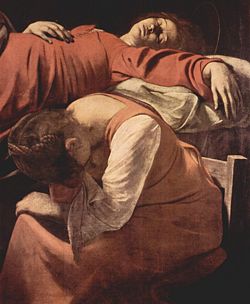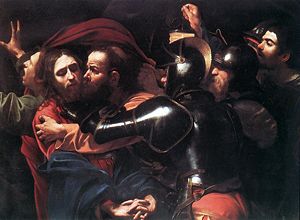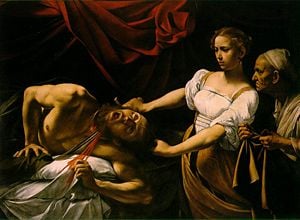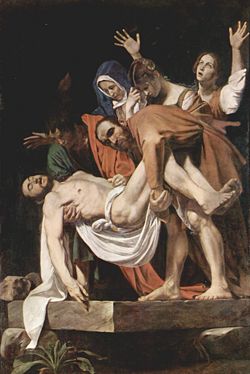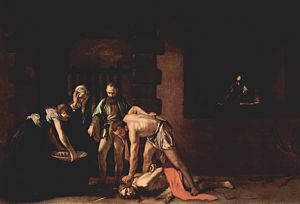Caravaggio
| Caravaggio | |
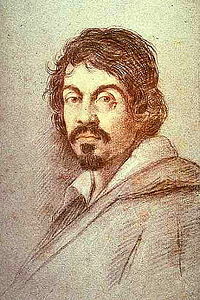 Chalk portrait of Caravaggio by Ottavio Leoni, c. 1621. | |
| Birth name | Michelangelo Merisi da Caravaggio |
| Born | September 29 1571 Milan |
| Died | 18 July 1610 (Aged 38) Porto Ercole, near Grosseto in Tuscany |
| Nationality | Italian |
| Field | Painting |
| Famous works | see works by Caravaggio |
Michelangelo Merisi da Caravaggio (September 29, 1571 ‚Äď July 18, 1610) was an Italian artist active in Rome, Naples, Malta and Sicily between 1593 and 1610. He is commonly placed in the Baroque school, of which he was the first great representative.
Caravaggio was considered enigmatic, fascinating, rebellious, and dangerous. He burst upon the Rome art scene in 1600, and thereafter never lacked for commissions or patrons, yet handled his success atrociously. An early published notice on him, dating from 1604 and describing his lifestyle some three years previously, tells how "after a fortnight's work he will swagger about for a month or two with a sword at his side and a servant following him, from one ball-court to the next, ever ready to engage in a fight or an argument, so that it is most awkward to get along with him."[1] In 1606 he killed a young man in a brawl and fled from Rome with a price on his head. In Malta in 1608 he was involved in another brawl, and yet another in Naples in 1609, possibly a deliberate attempt on his life by unidentified enemies. By the next year, after a career of little more than a decade, he was dead.
Huge new churches and palazzi were being built in Rome in the decades of the late sixteenth and early seventeenth centuries, and paintings were needed to fill them. The Counter-Reformation Church searched for authentic religious art with which to counter the threat of Protestantism, and for this task the artificial conventions of Mannerism, which had ruled art for almost a century, no longer seemed adequate. Caravaggio's novelty was a radical naturalism which combined close physical observation with a dramatic, even theatrical, approach to chiaroscuro, the use of light and shadow.
Life and Art
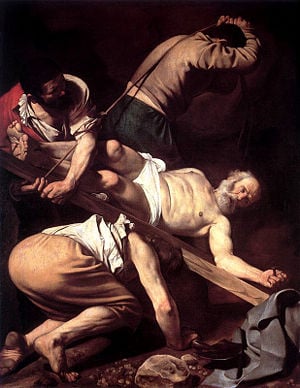
Early life (1571‚Äď1592)
Caravaggio was born in Milan,[2] where his father, Fermo Merisi, was a household administrator and architect-decorator to Francesco Sforza, Marchese of Caravaggio, Italy. His mother, Lucia Aratori, came from a propertied family of the same district. In 1576 the family moved to Caravaggio to escape a plague which ravaged Milan. Caravaggio’s father died there in 1577. It is assumed that the artist grew up in Caravaggio, but his family kept up connections with the Sforzas and with the powerful Colonna family, who were allied by marriage with the Sforzas, and destined to play a major role in Caravaggio's later life.[3]
In 1584 he was apprenticed for four years to the Lombard painter Simone Peterzano, described in the contract of apprenticeship as a pupil of Titian. Caravaggio appears to have stayed in the Milan-Caravaggio area after his apprenticeship ended, but it is possible that he visited Venice and saw the works of Giorgione, whom he was later accused of aping, and of Titian. Certainly he would have become familiar with the art treasures of Milan, including Leonardo’s The Last Supper, and with the regional Lombard art, a style which valued "simplicity and attention to naturalistic detail"[4] and was closer to the naturalism of Germany than to the stylized formality and grandeur of Roman Mannerism.
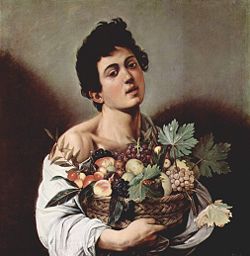
In mid-1592 Caravaggio arrived in Rome, ‚Äúnaked and extremely needy ‚Ķ without fixed address and without provision ‚Ķ short of money.‚ÄĚ[5] A few months later he was performing hack-work for the highly successful Giuseppe Cesari, Pope Clement VIII‚Äôs favorite painter, ‚Äúpainting flowers and fruit‚ÄĚ[6] in his factory-like workshop. Known works from this period include a small Boy Peeling Fruit (his earliest known painting), a Boy with a Basket of Fruit, and the Young Sick Bacchus, supposedly a self-portrait done during convalescence from a serious illness that ended his employment with Cesari. All three demonstrate the physical particularity‚ÄĒone aspect of his realism‚ÄĒfor which Caravaggio was to become renowned: the fruit-basket-boy‚Äôs produce has been analyzed by a professor of horticulture, who was able to identify individual cultivars right down to "‚Ķa large fig leaf with a prominent fungal scorch lesion resembling anthracnose (Glomerella cingulata)."[7]
From Boy to Man
Caravaggio left Cesari in January 1594, determined to make his own way. His fortunes were at their lowest ebb, yet it was now that he forged some extremely important friendships, with the painter Prospero Orsi, the architect Onorio Longhi, and the 16-year-old Sicilian artist Mario Minniti. Orsi, established in the profession, introduced him to influential collectors; Longhi, more balefully, introduced him to the world of Roman street-brawls; and Minniti served as a model and, years later, would be instrumental in helping Caravaggio to important commissions in Sicily.[8] The Fortune Teller, his first composition with more than one figure, shows Mario being cheated by a gypsy girl. The theme was quite new for Rome, and proved immensely influential over the next century and beyond. This, however, was in the future: at the time, Caravaggio sold it for practically nothing. The Cardsharps‚ÄĒshowing another unsophisticated boy falling victim of card cheats‚ÄĒis even more psychologically complex, and perhaps Caravaggio‚Äôs first true masterpiece. Like the The Fortune Teller it was immensely popular, and over 50 copies survive. More importantly, it attracted the patronage of Cardinal Francesco Maria Del Monte, one of the leading connoisseurs in Rome. For Del Monte and his wealthy art-loving circle Caravaggio executed a number of intimate chamber-pieces‚ÄĒThe Musicians, The Lute Player, a tipsy Bacchus, an allegorical but realistic Boy Bitten by a Lizard‚ÄĒfeaturing Minniti and other boy models.[9] The allegedly homoerotic ambience of these paintings has been the center of considerable dispute amongst scholars and biographers since it was first raised in the later half of the twentieth century.[10]
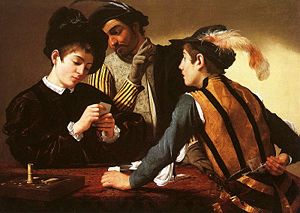
The realism returned with Caravaggio‚Äôs first paintings on religious themes, and the emergence of remarkable spirituality. The first of these was the Penitent Magdalene, showing Mary Magdalene at the moment when she has turned from her life as a courtesan and sits weeping on the floor, her jewels scattered around her. ‚ÄúIt seemed not a religious painting at all ‚Ķ a girl sitting on a low wooden stool drying her hair ‚Ķ. Where was the repentance ‚Ķ suffering ‚Ķ promise of salvation?‚ÄĚ[11] It was understated, in the Lombard manner, not histrionic in the Roman manner of the time. It was followed by others in the same style: Saint Catherine, Martha and Mary Magdalene, Judith Beheading Holofernes, a Sacrifice of Isaac, a Saint Francis of Assisi in Ecstasy, and a Rest on the Flight into Egypt. The works, while viewed by a comparatively limited circle, increased Caravaggio's fame with both connoisseurs and his fellow-artists. But a true reputation would depend on public commissions, and for these it was necessary to look to the Church.
'Most famous painter in Rome' (1600‚Äď1606)
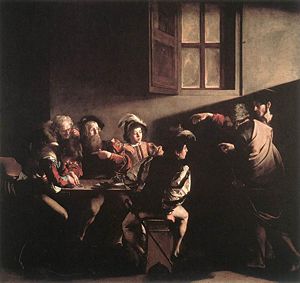
In 1599, presumably through the influence of Del Monte, Caravaggio contracted to decorate the Contarelli Chapel in the church of San Luigi dei Francesi. The two works making up the commission, the Martyrdom of Saint Matthew and The Calling of St. Matthew, delivered in 1600, were an immediate sensation. Caravaggio’s tenebrism (a heightened chiaroscuro) brought high drama to his subjects, while his acutely observed realism brought a new level of emotional intensity. Opinion among Caravaggio’s artist peers was polarized. Some denounced him for various perceived failings, notably his insistence on painting from life, without drawings, but for the most part he was hailed as the savior of art: "The painters then in Rome were greatly taken by this novelty, and the young ones particularly gathered around him, praised him as the unique imitator of nature, and looked on his work as miracles."[12]
Caravaggio went on to secure a string of prestigious commissions for religious works featuring violent struggles, grotesque decapitations, torture and death. For the most part each new painting increased his fame, but a few were rejected by the various bodies for whom they were intended, at least in their original forms, and had to be re-painted or find new buyers. The essence of the problem was that while Caravaggio‚Äôs dramatic intensity was appreciated, his realism was seen by some as unacceptably vulgar.[13] His first version of Saint Matthew and the Angel, featured the saint as a bald peasant with dirty legs attended by a lightly-clad over-familiar boy-angel, was rejected and had to be repainted as The Inspiration of Saint Matthew. Similarly, The Conversion of Saint Paul was rejected, and while another version of the same subject, the Conversion on the Way to Damascus, was accepted, it featured the saint‚Äôs horse‚Äôs haunches far more prominently than the saint himself, prompting this exchange between the artist and an exasperated official of Santa Maria del Popolo: ‚ÄúWhy have you put a horse in the middle, and Saint Paul on the ground?‚ÄĚ ‚ÄúBecause!‚ÄĚ ‚ÄúIs the horse God?‚ÄĚ ‚ÄúNo, but he stands in God‚Äôs light!‚ÄĚ[14]
Other works included the deeply moving The Entombment of Christ, the Madonna di Loreto (Madonna of the Pilgrims), the Madonna and Child with Saint Anne, and the Death of the Virgin. The history of these last two paintings illustrate the reception given to some of Caravaggio's art, and the times in which he lived. (Dei Palafrenieri), also known as Madonna and Child with St. Anne, painted for a small altar in Saint Peter's Basilica in Rome, remained there for just two days, and was then taken off. The Death of the Virgin, then, commissioned in 1601 by a wealthy jurist for his private chapel in the new Carmelite church of Santa Maria della Scala, was rejected by the Carmelites in 1606. Caravaggio's contemporary Giulio Mancini records that it was rejected because Caravaggio had used a well-known prostitute as his model for the Virgin;[15] Giovanni Baglione, another contemporary, tells us it was due to Mary's bare legs[16]‚Äďa matter of decorum in either case. Caravaggio scholar John Gash suggests that the problem for the Carmelites may have been theological rather than aesthetic, in that Caravaggio's version fails to assert the doctrine of the Assumption of Mary, the idea that the Mother of God did not die in any ordinary sense but was assumed into Heaven. The replacement altarpiece commissioned (from one of Caravaggio's most able followers, Carlo Saraceni), showed the Virgin not dead, as Caravaggio had painted her, but seated and dying; and even this was rejected, and replaced with a work which showed the Virgin not dying, but ascending into Heaven with choirs of angels. In any case, the rejection did not mean that Caravaggio or his paintings were out of favor. The Death of the Virgin was no sooner taken out of the church than it was purchased by the Duke of Mantua, on the advice of Rubens, and later acquired by Charles I of England before entering the French royal collection in 1671.
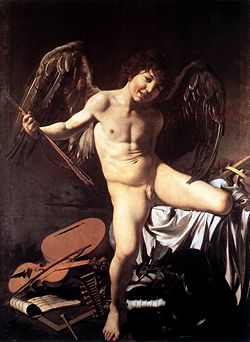
One secular piece from these years is Amor Vincit Omnia, painted in 1602 for Vincenzo Giustiniani, a member of Del Monte‚Äôs circle. The model was named in a memoir of the early seventeenth century as "Cecco," the diminutive for Francesco. He is possibly Francesco Boneri, identified with an artist active in the period 1610-1625 and known as Cecco del Caravaggio ('Caravaggio's Cecco'),[17] carrying a bow and arrows and trampling symbols of the warlike and peaceful arts and sciences underfoot. He is unclothed, and it is difficult to accept this grinning urchin as the Roman god Cupid‚Äďas difficult as it was to accept Caravaggio‚Äôs other semi-clad adolescents as the various angels he painted in his canvases, wearing much the same stage-prop wings. The point, however, is the intense yet ambiguous reality of the work: it is simultaneously Cupid and Cecco, as Caravaggio‚Äôs Virgins were simultaneously the Mother of Christ and the Roman prostitutes who modeled for them.
Exile and death (1606‚Äď1610)
Caravaggio led a tumultuous life. He was notorious for brawling, even in a time and place when such behavior was commonplace, and the transcripts of his police records and trial proceedings fill several pages. On May 29, 1606, he killed, possibly unintentionally, a young man named Ranuccio Tomassoni.[18] Previously his high-placed patrons had protected him from the consequences of his escapades, but this time they could do nothing. Caravaggio, outlawed, fled to Naples. There, outside the jurisdiction of the Roman authorities and protected by the Colonna family, the most famous painter in Rome became the most famous in Naples. His connections with the Colonnas led to a stream of important church commissions, including the Madonna of the Rosary, and The Seven Works of Mercy.
Despite his success in Naples, after only a few months in the city Caravaggio left for Malta, the headquarters of the Knights of Malta, presumably hoping that the patronage of Alof de Wignacourt, Grand Master of the Knights, could help him secure a pardon for Tomassoni's death. De Wignacourt proved so impressed at having the famous artist as official painter to the Order that he inducted him as a knight, and the early biographer Bellori records that the artist was well pleased with his success. Major works from his Malta period include a huge The Beheading of Saint John the Baptist (the only painting to which he put his signature) and a Portrait of Alof de Wignacourt and his Page, as well as portraits of other leading knights. Yet by late August of 1608 he was arrested and imprisoned. The circumstances surrounding this abrupt change of fortune have long been a matter of speculation, but recent investigation has revealed it to have been the result of yet another brawl, during which the door of a house was battered down and a knight seriously wounded.[19] By December he had been expelled from the Order "as a foul and rotten member."[20]
Before the expulsion Caravaggio had escaped to Sicily and the company of his old friend Mario Minniti, who was now married and living in Syracuse. Together they set off on what amounted to a triumphal tour from Syracuse to Messina and on to the island capital, Palermo. In each city Caravaggio continued to win prestigious and well-paid commissions. Among other works from this period are a Burial of St. Lucy, The Raising of Lazarus, and an Adoration of the Shepherds. His style continued to evolve, showing now friezes of figures isolated against vast empty backgrounds. "His great Sicilian altarpieces isolate their shadowy, pitifully poor figures in vast areas of darkness; they suggest the desperate fears and frailty of man, and at the same time convey, with a new yet desolate tenderness, the beauty of humility and of the meek, who shall inherit the earth."[21] Contemporary reports depict a man whose behavior was becoming increasingly bizarre, sleeping fully armed and in his clothes, ripping up a painting at a slight word of criticism, mocking the local painters.[22]
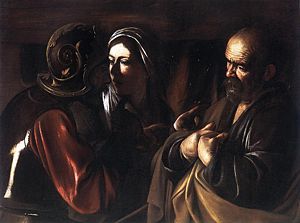
After only nine months in Sicily Caravaggio returned to Naples. According to his earliest biographer he was being pursued by enemies while in Sicily and felt it safest to place himself under the protection of the Colonnas until he could secure his pardon from the pope (now Paul V) and return to Rome.[23] In Naples he painted The Denial of Saint Peter, a final John the Baptist, and, his last picture, The Martyrdom of Saint Ursula. His style continued to evolve‚ÄďSaint Ursula is caught in a moment of highest action and drama, as the arrow fired by the king of the Huns strikes her in the breast, unlike earlier paintings which had all the immobility of the posed models. The brushwork was much freer and more impressionistic. Had Caravaggio lived, something new would have come.
In Naples an attempt was made on his life, by persons unknown. At first it was reported in Rome that the "famous artist" Caravaggio was dead, but then it was learned that he was alive, but seriously disfigured in the face. He painted a Salome with the Head of John the Baptist (Madrid), showing his own head on a platter, and sent it to de Wignacourt as a plea for forgiveness. Perhaps at this time he painted also a David with the Head of Goliath, showing the young David with a strangely sorrowful expression gazing on the wounded head of the giant, which is, again, Caravaggio's. This painting he may have sent to the unscrupulous art-loving cardinal-nephew Scipione Borghese, who had the power to grant or withhold pardons.[24]
In the summer of 1610 he took a boat northwards to receive the pardon, which seemed imminent thanks to his powerful Roman friends. With him were three last paintings, gifts for Cardinal Scipione.[25] What happened next is the subject of much confusion and conjecture. The bare facts are that on July 28 an anonymous avviso (private newsletter) from Rome to the ducal court of Urbino reported that Caravaggio was dead. Three days later another avviso said that he had died of fever. These were the earliest, brief accounts of his death, which later underwent much elaboration. No body was found.[26] A poet friend of the artist later gave July 18 as the date of death, and a recent researcher claims to have discovered a death notice showing that the artist died on that day of a fever in Porto Ercole,[27] near Grosseto in Tuscany.
Caravaggio the artist
The birth of Baroque
Caravaggio ‚Äúput the oscuro (shadows) into chiaroscuro.‚ÄĚ[28] Chiaroscuro was practiced long before he came on the scene, but it was Caravaggio who made the technique definitive, darkening the shadows and transfixing the subject in a blinding shaft of light. With this went the acute observation of physical and psychological reality which formed the ground both for his immense popularity and for his frequent problems with his religious commissions. He worked at great speed, from live models, scoring basic guides directly onto the canvas with the end of the brush handle. The approach was anathema to the skilled artists of his day, who decried his refusal to work from drawings and to idealize his figures. Yet the models were basic to his realism. Some have been identified, including Mario Minniti and Francesco Boneri, both fellow-artists, as figures in his work. Mario appeared as various figures in the early secular works while the young Francesco portrayed a succession of angels, Baptists and Davids in the later canvasses. His female models include Fillide Melandroni, [[Martha and Mary Magdalene (Caravaggio)|Anna Bianchini]], and Maddalena Antognetti (the "Lena" mentioned in court documents of the "artichoke" case[29] as Caravaggio's concubine), all well-known prostitutes, who appear as female religious figures including the Virgin and various saints.[30] Caravaggio himself appears in several paintings, his final self-portrait being as the witness on the far right to the Martyrdom of Saint Ursula.[31]
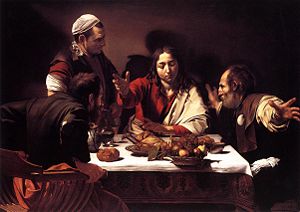
Caravaggio had a noteworthy ability to express in one scene of unsurpassed vividness the passing of a crucial moment. The Supper at Emmaus depicts the recognition of Christ by his disciples: a moment before he is a fellow traveler, mourning the passing of the Messiah, as he never ceases to be to the inn-keeper‚Äôs eyes, the second after, he is the Savior. In The Calling of St Matthew, the hand of the Saint points to himself as if he were saying ‚Äúwho, me?,‚ÄĚ while his eyes, fixed upon the figure of Christ, have already said, ‚ÄúYes, I will follow you.‚ÄĚ With The Raising of Lazarus, he goes a step further, giving us a glimpse of the actual physical process of resurrection. The body of Lazarus is still in the throes of rigor mortis, but his hand, facing and recognizing that of Christ, is alive. Other major Baroque artists would travel the same path, for example Bernini, fascinated with themes from Ovid‚Äôs Metamorphoses.
The Caravaggisti
The installation of the Saint Matthew paintings in the Contarelli Chapel had an immediate impact among the younger artists in Rome, and Caravaggism became the cutting edge for every ambitious young painter. The first Caravaggisti included Giovanni Baglione (although his Caravaggio phase was short-lived) and Orazio Gentileschi. In the next generation there were Carlo Saraceni, Bartolomeo Manfredi and Orazio Borgianni. Gentileschi, despite being considerably older, was the only one of these artists to live much beyond 1620, and ended up as court painter to Charles I of England. His daughter Artemisia Gentileschi was also close to Caravaggio, and one of the most gifted of the movement. Yet in Rome and in Italy it was not Caravaggio, but the influence of Annibale Carraci, blending elements from the High Renaissance and Lombard realism, which ultimately triumphed.
Caravaggio‚Äôs brief stay in Naples produced a notable school of Neapolitan Caravaggisti, including Battistello Caracciolo and Carlo Sellitto. The Caravaggisti movement there ended with a terrible outbreak of plague in 1656, but the Spanish connection‚ÄĒNaples was a possession of Spain‚ÄĒwas instrumental in forming the important Spanish branch of his influence.
A group of Catholic artists from Utrecht, the "Utrecht Caravaggisti," traveled to Rome as students in the first years of the seventeenth century and were profoundly influenced by the work of Caravaggio, as Bellori describes. On their return to the north this trend had a short-lived but influential flowering in the 1620s among painters like Hendrick ter Brugghen, Gerrit van Honthorst, Andries Both and Dirck van Baburen. In the following generation the affects of Caravaggio, although attenuated, are to be seen in the work of Rubens (who purchased one of his paintings for the Gonzaga of Mantua and painted a copy of the Entombment of Christ), Vermeer, Rembrandt, and Diego Velazquez, the last of whom presumably saw his work during his various sojourns in Italy.
Death and rebirth of a reputation
Caravaggio’s fame scarcely survived his death. His innovations inspired the Baroque, but the Baroque took the drama of his chiaroscuro without the psychological realism. He directly influenced the style of his companion Orazio Gentileschi, and his daughter Artemisia Gentileschi, and, at a distance, the Frenchmen Georges de La Tour and Simon Vouet, and the Spaniard Giuseppe Ribera. Yet within a few decades his works were being ascribed to less scandalous artists, or simply overlooked. The Baroque, to which he contributed so much, had moved on, and fashions had changed, but perhaps more pertinently Caravaggio never established a workshop as the Carraci's did, and thus had no school to spread his techniques. Nor did he ever set out his underlying philosophical approach to art, the psychological realism which can only be deduced from his surviving work. Thus his reputation was doubly vulnerable to the critical attacks by two of his earliest biographers, Giovanni Baglione, a rival painter with a personal vendetta, and the influential seventeenth century critic Giovan Bellori, who had not known him but was under the influence of the French Classicist Nicolas Poussin, who had not known him either but hated his work.[32]
In the 1920s art critic Roberto Longhi brought Caravaggio's name once more to public attention, and placed him in the European tradition: ‚ÄúRibera, Vermeer, La Tour and Rembrandt could never have existed without him. And the art of Delacroix, Courbet and Manet would have been utterly different.‚ÄĚ[33] The influential Bernard Berenson agreed: ‚ÄúWith the exception of Michelangelo, no other Italian painter exercised so great an influence.‚ÄĚ[34]
Modern tradition
Many large museums of art, for example those in Detroit and New York City, contain rooms where dozens of paintings by as many artists display the characteristic look of the work of Caravaggio‚Äďnighttime setting, dramatic lighting, ordinary people used as models, honest description from nature. In modern times, painters like the Norwegian Odd Nerdrum and the Hungarian Tibor Csernus make no secret of their attempts to emulate and update him, and the contemporary American artist Doug Ohlson pays homage to Caravaggio's influence on his own work. Filmmaker Derek Jarman turned to the Caravaggio legend when creating his movie Caravaggio; and Dutch art forger Han van Meegeren used genuine Caravaggios when creating his ersatz Old Masters.
Only about 50 works by Caravaggio survive. One, The Calling of Saints Peter and Andrew, was recently authenticated and restored. It had been in storage in Hampton Court, mislabeled as a copy. At least a couple of his paintings have been or may have been lost in recent times. Richard Francis Burton writes of a "picture of St. Rosario (in the museum of the Grand Duke of Tuscany), showing a circle of 30 men turpiter ligati" which is not known to have survived. Also, a painting of an Angel was destroyed during the bombing of Dresden, though there are black and white photographs of the work.
Major Works and Surrounding Circumstances
Boy With a Basket of Fruit (1593-1594)
In Rome, Caravaggio's art was coming to the surface in a frenzy. The Boy with a Basket of Fruit represents Caravaggio's youth in Lombardy. The details are intense and distinguished: the yellow leaf is about to fall and the ripe color of the fruits. There is a sense of both satisfaction and longing in the face of the boy, who, scholars claim, is a portrait of Caravaggio himself. The stream of light that cuts through the background is a naturalistic value that Caravaggio sought to pursue in his own style. The sense of motion in space is abundant due to the effect of light and the shadows it casts.
The Fortune Teller (1593-1594)
This painting was commissioned by Monsignor Petrignani, who had given Caravaggio a place to stay in 1595. Caravaggio's biographer, Giulio Mancini, said after the completion of the painting, "Of this school I do not think that I have seen a more graceful and expressive figure than the Gypsy who foretells good fortune to a young man by Caravaggio." [35] In fact, this painting, coupled with another masterpiece of Caravaggio, Cardsharps, form the core of the most imitated paintings from seventeenth century onward.
The Cardsharps (1594)
Cardinal Del Monte, who provided Caravaggio with a home as well, commissioned many of Caravaggio's paintings. It opened the doors of Roman aristocracy to Caravaggio and enjoyed so much success that it was copied over 50 times. In fact, this is one of Caravaggio's first works in which he tried to incorporate several figures on the canvas. "The three characters compose a three-dimensional effect in which the box of dice, the cards and the table contribute to the spatiality created by the expressions and gestures that connect them."[35] The way Caravaggio uses color and light illuminates the entire piece and adds emotion into the face of the figures.
The Musicians
The Musicians was representative of the typical cultural atmosphere in the cardinals' court, where music and art were often objects of discourse. There is an undertone of erotic sensations with the presence of Cupid picking the grapes. Caravaggio goes back to the classical style with the white clothes. "The naturalness of the poses are matched by the young men's enchanted expressions with partially open mouths and the shiny gazes directed outside of the painting breaking the intimacy of the representation… professed."[35]
David and Goliath
While many versions of this piece have been constructed by artists from different eras, Caravaggio's David and Goliath is the most naturalistic. In this piece, the deed has already been committed and David is intent on taking the head of Goliath. Chiaroscuro in this piece add emphasis on the anatomical parts of both figures, particularly the head of Goliath and the arm of David.
Judith Beheading Holofernes
Caravaggio used a courtesan, Fillide Melandroni, to play the role of Judith in this late sixteenth century painting. This soul-shattering painting takes viewers into the abyss of darkness, the darkness of reality. "The two figures are captured in the moment of exertion, watched by the old woman, the symbolic counterpart to Judith's beauty, which has a high precedent in Giulio Romano." [35]
The Calling of Saint Matthew
Used as a decorative art in the church of San Luigi dei Francesi, The Calling of Saint Matthew, portrayed two different environments, that of the darkened streets and the illuminated room full of love and hope. In this piece, there are several figures in motion simultaneously, which is a feat that Caravaggio had not attempted before. "The light is an effective symbolic and stylistic device to highlight the apparent historic dissonance between the modern clothes of Matthew and his companions and the few divine attributes of the apostle, barefoot, wrapped in a large classical cloak and Christ, above whose head is the glimmer of a thin golden halo."[35]
The Conversion of Saint Paul
On September 24, 1600, Caravaggio came to an agreement with Monsignor Tiberior Cerasi to paint paintings depicting both the mystery of Saint Paul and the martyrdom of Saint Peter. His first version of the Conversion of Saint Paul, was not accepted and as a result, Caravaggio made a revision and depicted Saint Paul an aura of ascension, an atmosphere of divinity. Saint Paul embraces the light that shines from above in a Christ-like pose.
Supper at Emmaus
The painting depicts the moment in which the disciples are exposed to the presence of Christ. This piece is rich with symbolism, particularly the Eucharist. It is the use of lighting in this piece that unifies the naturality of the piece.
The Betrayal of Christ
Ciriaco Mattei paid one hundred and twenty-five scudi for the Betrayal of Christ, which is now located in Dublin. In fact, this is the original copy that was thought lost for many years. The subject matter once again is of Christ, betrayed by Judas and captured by Roman soldiers. The small blotches of red are the only color in an otherwise darkened canvas. "The unabalancing that results, partly directed by the gleaming on the soldier's black armor, highlights the dynamic sense of the whole."[35]
The Sacrifice of Issac
This piece was done while Caravaggio was on house arrest for slander. "The work is a further instance of Caravaggio's studies of the dynamic of extreme expressions associated with acts of violence." [35]
Death of the Virgin
This piece was commissioned by Laerzio Cherubini to be placed in the altar of Santa Maria della Scala in Rome. Death of the Virgin was the largest of any painting that Caravaggio constructed in Rome. Unfortunately for him, it was removed upon completion, like many of other Caravaggios. The Madonna in the piece, with the exception of the halo behind her head, exhibited none of the divine qualities normally present in Mary paintings.
David with the Head of Goliath
From darkness comes the image of a triumphant David, fiercely clutching the severed head of Goliath. Many believe it was the head of Caravaggio himself, in his attempts to attain a pardon. The mouth is open to draw its last breath. "The brown trousers and ripped shirt that cover him are pieces of superior painting, a synthesis that uses long separate brushstrokes, and pairs the pure whites and grays in the shirt with an effect of transparency and tones of Lombard origins."[35]
The Seven Works of Mercy
Made for Pio Monte della Misericordia, The Seven Works of Mercy was clearly the most prestigious public work from Caravaggio. The circular motion along the axis adds heightened motion and drama in conjunction with the dynamic use of light. "The light bounces off of the masses, faces, and clothes, contributing to highlighting the new synthetic sense of the volumes of Caravaggio's Neapolitan period, while the candle lit by the character in the background of the composition enhances the painting's depth and forms its fulcrum.[35]
Portrait of a Knight of Malta, Fra Antonio Martelli
Caravaggio soon took up portraiture, particularly in the courts. It is difficult to imagine how Caravaggio could maintain the quality of his work, as he was always in and out of trouble with the law. Antonio Martelli was a seventy year old when the portrait was made, but had been a knight of the order of Saint John of Jerusalem in his youth. What is intriguing, and in doubt, is the lingering question: why would an acclaimed knight have Caravaggio, "who had just been run out of the order of knights of Malta as a putridum et foetidum" do his portrait?[35] The elderly knight's mortality is present as Caravaggio unsparingly depicts the wrinkles on his forehead. However, "the figure he cuts is far from that of an old man who has laid down his arms, and is marked by the light that highlights his still sturdy chest and his arm at the ready on his sword."[35]
Other works
- Self-Portrait as Sick Bacchus
- Saint Francis in Ecstasy
- Penitent Magdalen
- The Lute Player
- Boy Bitten by a Lizard
- The Rest on the Flight into Egypt
- Bacchus
- Saint Catherine of Alexandria
- Still Life with a Basket of Fruit
- Medusa
- Narcissus
- The Martyrdom of Saint Matthew
- The Crucifixion of Saint Peter
- The Incredulity of Saint Thomas
- Saint Matthew and the Angel
- Cupid
- Saint John the Baptist
- Deposition
- The Crowning with Thorns
- Madonna of Loreto
- Madonna of the Palafrenieri
- Saint Francis in Meditation
- Saint Jerome
- Saint Francis in Prayer
- The Flagellation of Christ
- Portrait of Alof de Wignacourt
- The Beheading of Saint John the Baptist
- The Burial of Saint Lucy
- The Denial of Saint Peter
- The Martyrdom of Saint Ursula
The Cicerone
In Jacob Burckhardt's The Cicerone Caravaggio's style is brought to the forefront. With Caravaggio begins, in quite a harsh way, the modern naturalism in Rome and Naples. Caravaggio's objective was to show that ordinary depictions of street life or family life was just as sacred, just as important as that of classical art. "He cares for nothing but passion, and has a great talent for expressing this in a truly volcanic manner." [36] Caravaggio's paintings normally exhibit a frenetic sense of movement that seem to culminate into the center of the canvas. Much of Caravaggio's art was created from live images doing normal things rather than the trend of the past in which one attempted to reenact history.
The Lost Painting: Caravaggio in the 20th Century and Beyond
Jonathan Harr's novel, The Lost Painting: The Quest for a Caravaggio Masterpiece, focused the mysterious disappearance of one of Caravaggio's lost paintings: The Taking of Christ. The emphasis is on Caravaggi's troubled life in the midst of his endless artistic talents. Roberto Longhi was responsible for resurrecting Caravaggio from the depths of obscurity. In 1941, he said that Caravaggio was, "One of the least known painters of Italian art." [37] While many of his paintings were considered vulgar in his time, his blunt realism attracted many followers, often known as Caravaggisti. In fact, many called it the "Caravaggio disease," because whether they liked it or disliked it, practically every art historian could not stray away from writing about Caravaggio and his art. Regardless, Caravaggio, through both his own nature and artistic talents, has propelled himself into a legacy unlike any other: art historians of all generations, passed and to come, will use his work as a means of catapulting into other works of art.
Legacy
Caravaggio was a larger than life figure both in his life and in his art. In the words of author Jonathan Harr, "The artist was Caravaggio, a master of the Italian Baroque. He was a genius, a revolutionary painter, and a man beset by personal demons. Four hundred years ago, he drank and brawled in the taverns and streets of Rome, moving from one rooming house to another, constantly in and out of jail, all the while painting works of transcendent emotional and visual power. He rose from obscurity to fame and wealth, but success didn't alter his violent temperament. His rage finally led him to commit murder, forcing him to flee Rome, a hunted man. He died young, along, and under strange circumstances." [38]
Famous and extremely influential while he lived, Caravaggio was almost entirely forgotten in the centuries after his death, and it was only in the 20th century that his importance to the development of Western art was rediscovered. Yet despite this his influence on the common style which eventually emerged from the ruins of Mannerism, the new Baroque, was profound. In fact, without Caravaggio's influence, many artists, such as Romanticist Eugene Delacroix would be painting in entirely different styles. Andre Berne-Joffroy, Paul Valéry’s secretary, said of him: "What begins in the work of Caravaggio is, quite simply, modern painting."[39]
Footnotes
- ‚ÜĎ Floris Claes van Dijk, a contemporary of Caravaggio in Rome in 1601, quoted in John Gash. Caravaggio. (Chaucer Press, 2004. ISBN 1904449220), 13. The quotation originates in Carl (or Karel) van Mander's Het Schilder-Boek of 1604, translated in full in Howard Hibbard, "Caravaggio." The first reference to Caravaggio in a contemporary document from Rome is the listing of his name, with that of Prospero Orsi as his partner, as an 'assistente' in a procession in October 1594 in honour of St. Luke (see H. Waga "Vita nota e ignota dei virtuosi al Pantheon" (Rome: 1992), Appendix I, 219 and 220ff). The earliest informative account of his life in the city is a court transcript dated July 11, 1597 where Caravaggio and Prospero Orsi were witnesses to a crime near San Luigi de' Francesi. (See Sandro Corradini and Maurizio Marini, "The earliest account of Caravaggio in Rome." The Burlington Magazine 25-28).
- ‚ÜĎ Confirmed by the finding of the baptism certificate from the Milanese parish of Santo Stefano in Brolo L'Unit√†, February 26, 2007.
- ‚ÜĎ The Colonna were one of the leading aristocratic families in Rome, and part of a network of powerful connections who supported the artist at crucial points in his life. Thus in 1606, following the death of Tomassoni, he fled first to the Colonna estates south of Rome, then on to Naples where Costanza Colonna Sforza, widow of Francesco Sforza, in whose husband's household Caravaggio's father had held a position, maintained a palace. Costanza's brother Ascanio was Cardinal-Protector of the Kingdom of Naples, another brother, Marzio, was an advisor to the Spanish Viceroy, and a sister was married into the important Neapolitan Carafa family‚Äďconnections which might help explain the cornucopia of major commissions which fell into Caravaggio's lap in that city. Costanza's son Fabrizio Sforza Colonna, Knights of Malta and general of the Order's galleys, appears to have facilitated his arrival in the island in 1607 and his escape the next year, and he stayed in Costanza's Neapolitan palazzo on his return there in 1609. These connections are treated in most biographies and studies‚Äďsee, for example, Catherine Puglisi, "Caravaggio," 258, for a brief outline. Helen Langdon. Caravaggio: A Life. (New York: Farrar, Straus and Giroux, 1999. ISBN 978-0374118945) chapters 12 and 15; Peter Robb. "M," (Duffy & Snellgrove, (1998) 2003. amended edition ISBN 978-1876631796), 398ff and 459ff, give a fuller account.
- ‚ÜĎ Rosa Giorgi. Caravaggio: Master of light and dark - his life in paintings. (Dorling Kindersley, 1999. ISBN 978-0789441386), 12.
- ‚ÜĎ Quoted without attribution in Robb, 35, apparently based on the three primary sources, Mancini, Baglione and Bellori, all of whom depict Caravaggio's early Roman years as a period of extreme poverty (see references below).
- ‚ÜĎ Giovanni Pietro Bellori, Le Vite de' pittori, scultori, et architetti moderni, 1672: "Michele was forced by necessity to enter the services of Cavalier Giuseppe d'Arpino, by whom he was employed to paint flowers and fruits so realistically that they began to attain the higher beauty that we love so much today."
- ‚ÜĎ Jules Janick, Caravaggio's Fruit: A Mirror on Baroque Horticulture Department of Horticulture and Landscape Architecture, Purdue University.
- ‚ÜĎ Catherine Puglisi, "Caravaggio," 79. Longhi was with Caravaggio on the night of the fatal brawl with Tomassoni; Robb, "M," 341, believes that Minniti was as well.
- ‚ÜĎ The critic Robert Hughes memorably described Caravaggio's boys as "overripe bits of rough trade, with yearning mouths and hair like black ice cream."
- ‚ÜĎ Donald Posner, "Caravaggio's Early Homo-erotic Works." Art Quarterly 24 (1971): 301-326) was the first to broach the subject of Caravaggio's sexuality and its relationship to his art. The gay biographers and commentators generally take a homoerotic content for granted, but the subject is complex. For a perceptive and well-sourced discussion, see Brian Tovar's "Sins Against Nature: Homoeroticism and the epistemology of Caravaggio" For an opposing viewpoint, see Maurizio Calvesi's "Caravaggio" (Rome: ArtDossier 1986), (in Italian). Calvesi argues that the early work reflects the Del Monte's taste rather than Caravaggio's, in the era before the advent of the modern concept of self-expression.
- ‚ÜĎ Robb, 79. Robb is drawing on Bellori, who praises Caravaggio's "true" colors but finds the naturalism offensive: "He (Caravaggio) was satisfied with the invention of nature without further exercising his brain."
- ‚ÜĎ Bellori. The passage continues: "[The younger painters] outdid each other in copying him, undressing their models and raising their lights; and rather than setting out to learn from study and instruction, each readily found in the streets or squares of Rome both masters and models for copying nature."
- ‚ÜĎ For an outline of the Counter-Reformation Church's policy on decorum in art, see Giorgi, 80. For a more detailed discussion, see Gash, 8ff; and for a discussion of the part played by notions of decorum in the rejection of "St Matthew and the Angel" and "Death of the Virgin," see Puglisi, 179-188.
- ‚ÜĎ Quoted without attribution in Lambert, 66.
- ‚ÜĎ Mancini, "Thus one can understand how badly some modern artists paint, such as those who, wishing to portray the Virgin Our Lady, depict some dirty prostitute from the Ortaccio, as Michelangelo da Caravaggio did in the Death of the Virgin in that painting for the Madonna della Scala, which for that very reason those good Fathers rejected it, and perhaps that poor man suffered so much trouble in his lifetime."
- ‚ÜĎ Baglione,` "For the [church of] Madonna della Scala in Trastevere he painted the death of the Madonna, but because he had portrayed the Madonna with little decorum, swollen and with bare legs, it was taken away, and the Duke of Mantua bought it and placed it in his most noble gallery."
- ‚ÜĎ While Gianni Papi's identification of Cecco del Caravaggio as Francesco Boneri is widely accepted, the evidence connecting Boneri to Caravaggio's servant and model in the early 1600s is circumstantial. See Robb, 193-196.
- ‚ÜĎ The circumstances of the brawl and the death of Ranuccio Tomassoni remain mysterious. Several contemporary avvisi referred to a quarrel over a gambling debt and a tennis game, and this explanation has become established in the popular imagination. But recent scholarship has made it clear that more was involved. Good modern accounts are to be found in Peter Robb's "M" and Helen Langdon's Caravaggio: A Life. An interesting theory relating the death to Renaissance notions of honor and symbolic wounding has been advanced by art historian Andrew Graham-Dixon, [1] Retrieved February 23, 2009.
- ‚ÜĎ The discovery of the evidence for this brawl was reported by Dr. Keith Sciberras of the University of Malta, in "Frater Michael Angelus in tumultu: the cause of Caravaggio‚Äôs imprisonment in Malta." The Burlington Magazine CXLV (April 2002): 229-232, and "Riflessioni su Malta al tempo del Caravaggio," Paragone Arte Anno LII (629) (July 2002): 3-20. Sciberras' findings are summarized online at Caravaggio.com.
- ‚ÜĎ This was the formal phrase used in all such cases. The senior knights of the Order convened on December 1, 1608 and, after verifying that the accused had failed to appear although summoned four times, voted unanimously to expel their putridum et foetidum ex-brother. Caravaggio was expelled, not for his crime, but for having left Malta without permission (i.e., escaping).
- ‚ÜĎ Langdon, 365.
- ‚ÜĎ Caravaggio displayed bizarre behavior from very early in his career. Mancini describes him as "extremely crazy," a letter of Del Monte notes his strangeness, and Mario Minniti's 1724 biographer says that Mario left Caravaggio because of his behavior. The strangeness seems to have increased after Malta. Susinno's early eighteenth century Le vite de' pittori Messinesi, ("Lives of the Painters of Messina,") provides several colorful anecdotes of Caravaggio's erratic behavior in Sicily, and these are reproduced in modern full-length biographies such as Langdon and Robb. Bellori writes of Caravaggio's "fear" driving him from city to city across the island and finally, "feeling that it was no longer safe to remain," to Naples. Baglione says Caravaggio was being "chased by his enemy," but like Bellori does not say who this enemy was.
- ‚ÜĎ Baglione says that Caravaggio in Naples had "given up all hope of revenge" against his unnamed enemy.
- ‚ÜĎ According to a seventeenth century writer the painting the head of Goliath is a self-portrait of the artist, while David is il suo Caravaggino, "his little Caravaggio." This phrase is obscure, but it has been interpreted as meaning either that the boy is a youthful self-portrait, or, more commonly, that this is the Cecco who modeled for the Amor Vincit. The sword-blade carries an abbreviated inscription which has been interpreted as meaning Humility Conquers Pride. Attributed to a date in Caravaggio's late Roman period by Bellori, the recent tendency is to see it as a product on Caravaggio's second Neapolitan period. (See Gash, 125).
- ‚ÜĎ A letter from the Bishop of Caserta in Naples to Cardinal Scipione Borghese in Rome, dated July 29, 1610, informs the Cardinal that the Marchesa of Caravaggio is holding two John the Baptists and a Magdalene which were intended for Borghese. These were presumably the price of Caravaggio's pardon from Borghese's uncle, the pope.
- ‚ÜĎ The avvisi placed Caravaggio's death at Porto Ercole while on his way from Naples to Rome. The letter from the Bishop of Caserta to Scipione Borghese on July 29, one day after the first avviso, says that Caravaggio died "not in Procida but at Porto Ercole." The bishop goes on to deny an earlier (lost) report that Caravaggio had died in Procida, and to say that instead Caravaggio's boat had stopped in Palo, where he had been imprisoned; the had boat returned to Naples, and Caravaggio had bought his release and gone on to Porto Ercole, "perhaps walking," where he died. None of these are intelligible as landing places for a man on his way to Rome: Procida is an island near Naples, Palo was a garrison in the marshes near the mouth of the Tiber but not well connected to the city‚ÄĒRome's port was at Civitavecchia, a little further north‚ÄĒand Porto Ercole lay a further hundred kilometers north of, and away from, Rome. See Robb, "M," 473ff.
- ‚ÜĎ Caravaggio death certificate 'found'. ARTS: BBC News accessdate 2005-12-22. There seems to be no later confirmation of this report.
- ‚ÜĎ Lambert, 11.
- ‚ÜĎ Much of the documentary evidence for Caravaggio's life in Rome comes from court records; the "artichoke" case refers to an occasion when the artist threw a dish of hot artichokes at a waiter.
- ‚ÜĎ Robb, passim, makes a fairly exhaustive attempt to identify models and relate them to individual canvases.
- ‚ÜĎ Caravaggio's self-portraits run from the Sick Bacchus at the beginning of his career to the head of Goliath in the David with the Head of Goliath in Rome's Borghese Gallery. Previous artists had included self-portraits as onlookers to the action, but Caravaggio's innovation was to include himself as a participant.
- ‚ÜĎ Also see criticism by fellow Italian Vincenzo Carducci (living in Spain) who nearly bemoans Caravaggio as an "Antichrist" of painting with "monstrous" talents of deception.
- ‚ÜĎ Roberto Longhi, quoted in Lambert, 15
- ‚ÜĎ Bernard Berenson, in Lambert, 8
- ‚ÜĎ 35.00 35.01 35.02 35.03 35.04 35.05 35.06 35.07 35.08 35.09 35.10 Francesca Marini. Caravaggio.
- ‚ÜĎ Jacob Burckhardt's The Cicerone
- ‚ÜĎ Harr, Jonathan. The Lost Painting: The Quest for a Caravaggio Masterpiece
- ‚ÜĎ Harr, Jonathan. The Lost Painting: The Quest for a Caravaggio Masterpiece
- ‚ÜĎ Quoted in Gilles Lambert, "Caravaggio," p.8.
ReferencesISBN links support NWE through referral fees
- Campbell, Donna M., Literary Realism WSU.edu. Retrieved August 13, 2007
- Eisenmann, Stephen F. Nineteenth Century Art, A Critical History. Thames and Hudson 2nd Ed. 2002. ISBN 0500283354.
- Gardner, Helen. Art Through the Ages, Sixth Ed. Harcourt Brace Jovanovich, Inc. 1975. ISBN 0155037536.
- Harr, Jonathan. The Lost Painting: The Quest for a Caravaggio Masterpiece. New York: Random House. ISBN 0375508015.
- Hartt, Frederick. Art: A History of Painting, Sculpture, Architecture. New York: Harry N. Abrams, Inc., 1989.
- Marini, Francesca. Caravaggio. Milano: RCS Libri Spa, 2004.
Other References
Primary sources
The main primary sources for Caravaggio's life are:
- Giulio Mancini's comments on Caravggio in Considerazioni sulla pittura, c.1617-1621
- Giovanni Baglione's Le vite de' pittori, 1642
- Giovanni Pietro Bellori's Le Vite de' pittori, scultori et architetti moderni, 1672
All have been reprinted in Howard Hibbard's "Caravaggio" and in the appendices to Catherine Puglisi's "Caravaggio," while Baglione's biography is available online (see External links section).
Secondary sources
- Calvesi, Maurizio. Caravaggio. Art Dossier, 1986, Giunti Editori, 1986 (ISBN not available)
- Friedlaender, Walter. Caravaggio Studies. Princeton, NJ: Princeton University Press, 1955.
- Gash, John. Caravaggio. Chaucer Press, 2004. ISBN 1904449220.
- Giorgi, Rosa. Caravaggio: Master of light and dark - his life in paintings. Dorling Kindersley, 1999. ISBN 978-0789441386.
- Hibbard, Howard. Caravaggio. 1983. ISBN 978-0064333221.
- Koch, Pietro. Caravaggio - The Painter of Blood and Darkness. Rome: Gunther Edition, 2004.
- Lambert, Gilles. Caravaggio. Taschen, 2000. ISBN 978-3822863053.
- Langdon, Helen. Caravaggio: A Life. Farrar, Straus and Giroux, 1999. ISBN 978-0374118945.
- Moir, Alfred. The Italian Followers of Caravaggio. Harvard University Press, (1967) (ISBN not available)
- Puglisi, Catherine. Caravaggio. Phaidon, 1998. ISBN 978-0714839660.
- Robb, Peter. M. Duffy & Snellgrove, (1998) 2003. amended edition ISBN 978-1876631796.
- Spike, John, with assistance from Michèle Kahn Spike, Caravaggio, with Catalogue of Paintings on CD-ROM, New York: Abbeville Press, 2001. ISBN 978-0789206398.
External links
All links retrieved November 25, 2023.
- Caravaggio, The Night Prince
- Caravaggio and the Camera Obscura
- Caravaggio's incisions by Ramon van de Werken
- Caravaggio, Michelangelo Merisi da Caravaggio WebMuseum, Paris webpage
Credits
New World Encyclopedia writers and editors rewrote and completed the Wikipedia article in accordance with New World Encyclopedia standards. This article abides by terms of the Creative Commons CC-by-sa 3.0 License (CC-by-sa), which may be used and disseminated with proper attribution. Credit is due under the terms of this license that can reference both the New World Encyclopedia contributors and the selfless volunteer contributors of the Wikimedia Foundation. To cite this article click here for a list of acceptable citing formats.The history of earlier contributions by wikipedians is accessible to researchers here:
The history of this article since it was imported to New World Encyclopedia:
Note: Some restrictions may apply to use of individual images which are separately licensed.
